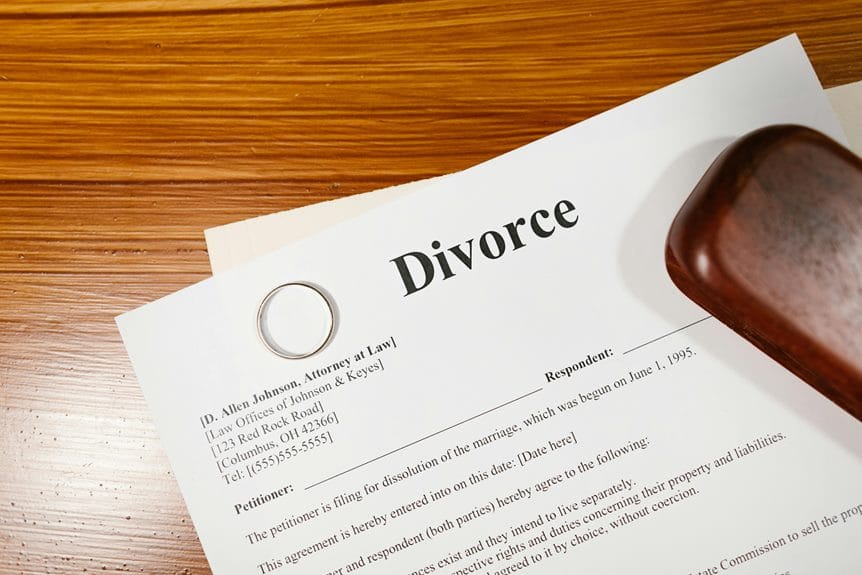Estate planning is about more than wills and inheritance. A binding financial agreement (BFA) can act as a planning [...]
Wondering how long a divorce takes in Australia? The process can be a whirlwind of emotions and logistics. Typically, after filing, it takes about four months to finalise. But keep in mind, a 12-month separation period is required first. Now, what if child custody or property disputes pop up? These issues can really drag things out. So, cooperation and clear documentation are your best friends here. Interested in the legal steps or how to tackle potential hiccups along the way? Getting a grip on these elements is crucial for a smoother ride. But how do you effectively navigate this complex journey?
Think of it like preparing for a long road trip. You need a map (or GPS these days), snacks, and maybe some tunes to keep the mood light. The divorce process is similar. Stay informed, keep communication open, and perhaps have a laugh when you can. Remember, it’s about making the journey as painless as possible.

What is the Divorce Process in Australia?
To comprehend the divorce process in Australia, you’ll initially need to be familiar with the divorce application, which can be lodged online or through the court. Lodging involves several steps, including meeting the 12-month separation requirement and choosing between a sole or joint application. The Family Court plays a crucial role by confirming the irretrievable breakdown of the marriage and ensuring all legal criteria are satisfied before granting a Divorce Order.
Understanding the Divorce Application
Commencing the divorce process in Australia necessitates an understanding of the essential steps and requirements that govern the procedure. To apply for a divorce, you must first submit a divorce application, which can be done either as a sole application or a joint application. Joint applications are generally processed more swiftly. Before you can file, ensure that you have been separated for at least 12 months. Once submitted, there is a mandatory one-month waiting period before a divorce hearing is scheduled. During this hearing, the court verifies that all legal requirements have been met. If you are the sole applicant or have children under 18, your attendance may be necessary. After the hearing, the divorce is finalised one month and one day later, concluding the process.

Steps to File for Divorce
Filing for divorce in Australia involves a clear series of steps designed to ensure fairness and compliance with legal requirements. Begin by confirming you have been separated for at least 12 months, demonstrating the marriage’s irretrievable breakdown. You can lodge a divorce application online or through the court, choosing either a sole or joint application. Joint applications often expedite the legal process and may exempt you from attending the divorce hearing. After lodging, there is a mandatory one-month waiting period before the hearing. During the hearing, the court reviews your application to verify that all legal criteria are met. Once the court grants a divorce, the divorce order becomes final one month and one day later, concluding the divorce proceedings in Australia.
The Role of the Family Court in Divorce
The Family Court of Australia plays a crucial role in the divorce process, ensuring that all proceedings adhere to legal standards and that the dissolution of marriage is justly managed. When you submit an application for divorce, the Family Court reviews it to confirm the irretrievable breakdown of the marriage. This includes verifying a 12-month separation period and assessing arrangements for the children of the marriage. Opting for a joint application can streamline the legal procedures, often allowing you to bypass attending a hearing. After the court hearing, there is a mandatory waiting period of one month and one day before the divorce order takes effect. This period ensures all aspects, including financial and parental responsibilities, are ready to finalise.
How Long Does it Take to Get a Divorce in Australia?
When you’re considering how long it takes to get a divorce in Australia, it’s essential to understand the factors that can affect the timeframe. While the typical duration from filing to completion is around four months, this can vary based on issues like child custody disputes or property settlements. Knowing why some divorces take longer than others can help you prepare for potential delays and manage your expectations.

Factors Affecting the Timeframe
Navigating a divorce in Australia can either be straightforward or protracted, depending on various factors. The duration of the divorce process often depends on the complexity of the case. If financial disputes or child custody issues arise, there may be potential extensions beyond the typical four-month timeframe. Engaging experienced divorce solicitors can assist in navigating these complexities when you apply to the court. Cooperation between both parties is crucial; it can expedite proceedings, whereas a lack of communication or disputes can lead to delays. Even simple tasks such as serving divorce papers can take longer than anticipated if there is resistance or incorrect documentation. Court availability also plays a role, as caseloads may result in one-month scheduling delays. Being prepared and proactive is essential to managing these factors effectively.
The Typical Duration for Divorce Proceedings
Understanding the timeline of divorce proceedings in Australia can assist you in preparing for the journey ahead. Under family law in Australia, a mandatory 12-month separation period is required before you can apply for divorce. Once you’ve lodged the divorce application, anticipate a waiting period of one month before your hearing is scheduled. After the hearing, the divorce is granted and takes one month and one day to be finalised. In total, the minimum time from separation to finalisation generally spans around 13 months. However, on average, the duration for divorce proceedings is approximately four months from the application lodging to finalisation. Bear in mind, various factors can influence how long it takes to finalise a divorce, impacting the overall timeline.
Why Some Divorces Take Longer Than Others
In Australia, divorce timelines can vary significantly, primarily due to the complexity of each case. While the divorce itself does not determine issues such as child custody or financial matters, these elements may take longer to resolve. Complex cases involving disputes over assets or children often require additional hearings, considerably extending the process. If one party does not respond to divorce papers, it can further delay proceedings, necessitating court intervention. Missing documentation is another common pitfall, often leading to rescheduled hearings and prolonged waiting times. Additionally, the court’s caseload can impact the timeline, with busier courts stretching the duration of your divorce. To navigate these hurdles effectively, ensure all paperwork is accurately completed and be prepared for potential delays arising from unforeseen complexities.
What Are the Legal Requirements for Divorce in Australia?
Before filing for divorce in Australia, ensure you meet the legal requirements, starting with a minimum of 12 months of separation. It’s essential to address arrangements for any children involved, as the court prioritises their welfare. Understanding the nuances of family law will help you navigate the process smoothly and meet all eligibility criteria.
Eligibility Criteria: At Least 12 Months of Separation
In Australia, an essential legal requirement before you can file for divorce is that you must have been separated for at least 12 months. This separation can include living under the same roof, provided it’s clear the relationship has ended. To grant the divorce, the court needs evidence of this irretrievable breakdown. When filing the application, verify you meet all criteria, including arrangements for any children under the age of 18. It’s wise to seek legal advice to navigate the process effectively. You may need to attend counselling if your marriage lasted less than two years unless exempted. Remember, at least one spouse must be an Australian citizen or resident, and proper documentation is vital when submitting your application with the court.

The Importance of Proper Arrangements for Children
When you’re going through a divorce in Australia, making proper arrangements for your children is essential. Before the divorce can be finalised, you must establish clear parenting plans and child support arrangements. These are scrutinised by the Family Court to guarantee they prioritise your children’s best interests. A joint application for divorce can simplify the process, as it often exempts both parties from attending the hearing if you’ve agreed on arrangements for children. Consulting a family lawyer for legal representation can help you navigate these requirements effectively. Remember, non-compliance with child support arrangements can lead to legal action. Guaranteeing enforceable and thorough agreements will not only meet legal requirements but also provide stability for your children’s future.
Understanding Family Law in Australia
Embarking on the journey of divorce in Australia necessitates a clear comprehension of the legal framework governing the process. Divorce signifies the legal dissolution of a marriage, and the federal circuit and family court oversees this. You must be separated for at least 12 months before lodging an application. If you have been married for less than two years, attendance at counselling or an explanation for its absence is required. You may opt for a sole application or a joint application for divorce; the latter is generally quicker. Arrangements for children under 18 must be addressed, as the court considers these. It is important to note that at least one party must be an Australian citizen or resident. The final decree is issued by the court, determining the duration of the process.
How is Property Settlement Handled in a Divorce?
In managing property settlement during a divorce in Australia, you will need to navigate several important steps to ensure a fair division of assets and debts. The Family Court of Australia plays a significant role in overseeing this process, particularly if you and your former partner cannot reach an agreement on your own. Bear in mind that the divorce proceedings might affect the timeline and complexity of your property settlement, so it is essential to remain informed and proactive.
Steps for a Fair Property Settlement
Navigating a fair property settlement in a divorce requires careful planning and open communication between both parties. Begin by discussing the division of assets acquired while living under one roof. Initiate settlement discussions early, as a property settlement typically takes a few months to finalise. Keep in mind the 12-month limit for filing property settlement applications after divorce. Legal representation can be essential to ensure fair distribution of assets, debts, and finances, aligning with both parties’ contributions and future needs. Focus on transparency and cooperation to avoid lengthy disputes. A mutual agreement on the settlement terms can expedite the process considerably, reducing stress and uncertainty. Embrace this opportunity to achieve an equitable outcome for both parties involved.

The Role of the Family Court of Australia in Property Division
When navigating a divorce in Australia, understanding the role of the Family Court in property division is essential. The Family Court of Australia plays a crucial role in ensuring a just and equitable outcome in the division of assets. After a divorce order is issued, it is important to note that there is a 12-month limit for initiating property settlement proceedings. The court evaluates various factors, such as the duration of the marriage and each party’s contributions and future needs. Complexities in asset valuation can prolong the process, particularly when significant or hidden assets are involved. While mutual agreement expedites settlement, disputes may necessitate court intervention. Ultimately, the court’s aim is to balance the division fairly, considering the unique circumstances of your marriage.
The Impact of Divorce Proceedings on Property Settlement
Navigating the complexities of property settlement during divorce proceedings can significantly impact the overall timeline and outcome of your case. To ensure there is sufficient time for your divorce to be finalised, it is crucial to address property settlement promptly. Filing must occur within 12 months of a divorce order for married couples. Reaching a mutual agreement on asset division can expedite the process, avoiding protracted court battles. Consider financial contributions and future needs when negotiating. Complex assets may require valuation, potentially leading to delays. Engaging legal representation will help navigate these intricacies, providing guidance and advocacy. Remember, property settlement is a separate process from divorce, but its timely resolution is imperative for concluding your marital affairs smoothly and efficiently.
What Happens After a Divorce Order is Issued?
Once a divorce order is issued in Australia, your marriage officially ends one month and one day later. During this time, you cannot remarry, as the divorce is not yet finalised. After the waiting period, you can obtain a copy of the sealed divorce order, providing official documentation of your divorce.
When Does the Divorce Become Final?
After the court issues a Divorce Order, the official end of your marriage is forthcoming, but it won’t occur immediately. You’ll need to wait one month and one day before the divorce is final. During this period, the granting of a divorce allows you to emotionally adjust and make arrangements for any children involved. There’s no need to attend court again, as the process is now underway. Once the waiting period concludes, you’ll receive a certificate of divorce, confirming that you’re officially divorced. If you’re over the age of 18, you’re free to remarry. Sealed copies of the divorce become accessible only after this period. Remember, disputes over property or custody must be resolved separately, not within 12 months.

Can You Remarry Before the Divorce Order is Final?
In Australia, you cannot remarry until your divorce order is finalised, which occurs one month and one day after the court issues it. This mandatory waiting period ensures the legal status of your previous marriage is fully resolved. If you attempt to remarry before a divorce order becomes finalised, the second marriage would be invalid. To initiate the process, you must have been separated for at least 12 months before submitting your divorce application. During this time, ensure all aspects of your divorce, such as property settlements and child arrangements, are finalised. Only then can you confidently plan for your future without legal complications. Remember, the key is patience and thoroughness to avoid any setbacks in your journey towards remarriage.
Obtaining a Copy of the Divorce Order
While patiently waiting for your divorce order to become final, it’s prudent to consider obtaining a copy of this vital document. After the finalisation period of one month and one day, you can secure a sealed copy from the Family Court or Federal Circuit Court. This document is essential for future legal considerations, such as property settlements or, if applicable, addressing issues related to marriage under the age. Access is limited to you and your legal representatives to guarantee privacy and confidentiality. Retaining this sealed copy isn’t just practical; it’s indispensable. It holds key details like names, marriage date, and divorce date. With mastery over these steps, you’ll safeguard your legal rights and prepare for any future necessities.
Final Thoughts
In Australia, the path to divorce is like running a marathon, requiring a steady pace and patience. It starts with a mandatory 12-month separation period. Once that’s done, you can file for divorce, which typically takes about four months to finalise. However, if there are disagreements over child custody, property, or other matters, it can drag on longer than a soap opera plot twist.
To keep things on track, ensure all your paperwork is ready and consider getting legal advice. Working cooperatively with your ex-partner is like having a tailwind—it makes the journey much smoother and faster. So, buckle up and remember, a little teamwork can go a long way in speeding things up.

























